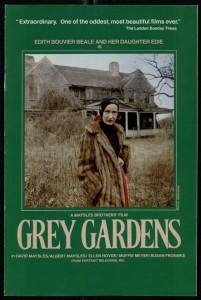
Nearly 40 years on, Albert and David Maysles’ Grey Gardens remains a stunning achievement. After a decade of successes, including Salesman (1968) and Gimme Shelter (1970), the Maysles turned their camera toward another fascinating subject. The film chronicles the lives of Edith and Little Edie Beale in their crumbling Gold Coast mansion, while they sing and dance about the years gone by and their status as outsiders from a once wonderful socialite existence.
The film still raises the same questions about the methods of documentary filmmaking and the possibility of exploitation, which is a good thing. Certain documentaries should make us aware not only of the subject, but of the filmmakers as well. We should question the motives of the men and women holding the cameras, and a good documentary should start a conversation rather than finish it. Both David and Albert always contended that their film was a truthful portrait of the women. Although the Beale’s behavior is troubling at times, it is also exuberant and powerful. That they were relatives of Jacqueline Kennedy Onassis gave the story some initial tabloid appeal, but when you strip away this back-story to focus solely on the women, we instead see them as fascinating subjects, and human beings, not just tabloid fodder. That their personalities are a little eccentric is certain, that the Maysles took advantage is less so. One object that is not in the gallery below is a letter of condolence from Little Edie to Judith Maysles after David’s untimely death. Years later, she still remembered him as a kind man, and if you listen closely to their interactions throughout the film, you can see that this was a loving portrait of two beautiful, if odd, women. Continue reading At the Archive: The David Maysles Collection at HGARC